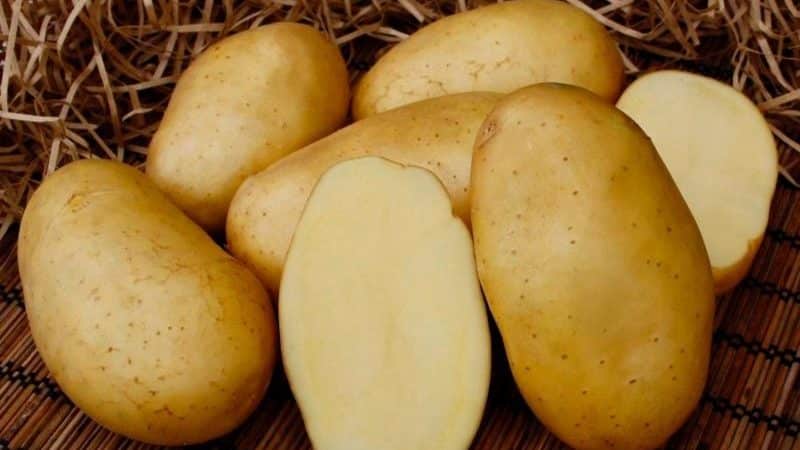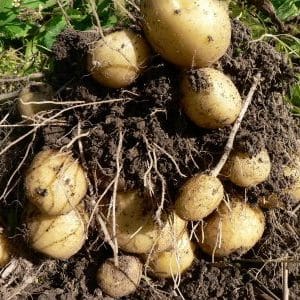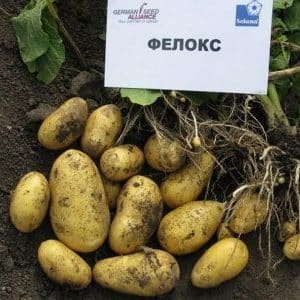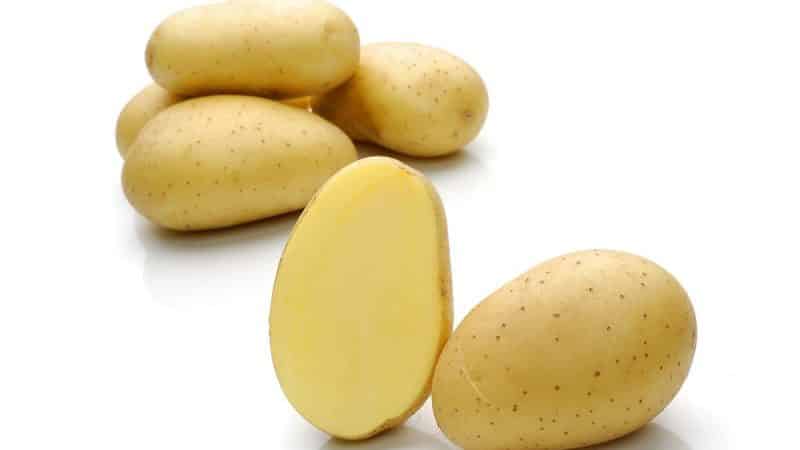Unpretentious potato variety "Phelox" with excellent taste
Gardeners carefully choose the potato variety to grow on their plot. Farmers value Felox for its high yields and excellent taste. The variety is easy to care for and resistant to many diseases.
Read our article about how to properly grow this crop on your personal plot.
Description of the variety
Felox potatoes are early ripening varieties. From the moment the tubers are planted until the harvest begins, 65-75 days pass.
The variety is popular due to its high productivity and universal use of root crops. Gives an excellent harvest even under unfavorable climatic conditions and sudden temperature changes. Famous for its taste.

Origin and development
The Felox potato variety was bred by breeders of the Saka Palanzenzucht company (Germany). The variety has become popular in Europe, India, China, and the CIS countries. This is explained by the fact that the crop easily adapts to different climatic conditions, tolerates temperature changes well and produces crops on any soil.
Since 1999 it has been grown in Russia. Distributed by the Sedek farm. The variety is recommended for cultivation in the Middle Volga region.
Chemical composition, trace elements and vitamins
Potato tubers contain proteins, carbohydrates, many vitamins, micro- and macroelements.
Vitamin content in 100 g of raw potatoes:
- A - 2.8 mcg;
- B1 - 0.15 mg;
- B2 - 0.6 mg;
- B5 - 0.32 mg;
- B6 - 0.31 mg;
- B9 - 0.8 mg;
- C - 22 mg;

- E - 0.12 mg;
- RR - 1.36 mg;
- beta-carotene - 0.02 mg.
Macronutrients:
- calcium - 11 mg;
- magnesium - 21 mg;
- sodium - 4.5 mg;
- potassium - 570 mg;
- phosphorus - 50 mg;
- sulfur - 30 mg;
- chlorine - 45 mg.
Microelements:
- iron - 0.92 mg;
- zinc - 0.3 mg;
- iodine - 5.2 mcg;
- copper - 138 mcg;
- manganese - 0.16 mg;
- fluorine - 28 mcg;
- boron - 118 mcg;
- aluminum - 855 mcg.
Calorie content - 80 kcal. Nutritional value per 100 g of product:
- proteins - 2.5 g;
- fats - 0.42 g;
- carbohydrates - 18 g;
- starch - 17 g;
- ash - 1 mg;
- water - 77 g;
- dietary fiber - 1.5 g;
- organic acids - 0.25 g.
Characteristics of tubers, description of appearance and yield
The variety is characterized by oblong-shaped tubers. The weight of each varies between 100-120 g, in rare cases individual specimens reach 200 g. The tubers have an amber-colored peel, the core is light when cut. The variety is characterized by high taste qualities and is suitable for preparing any culinary dishes. When peeling and cutting the potatoes do not darken. Tubers retain their presentation by 97% during long-term transportation.
The bushes of the variety are erect, well leafy. The leaves are large, toothed, dark green. The inner side of the sheet is glossy. The flowers are small, dark lilac in color.
This is an early ripening variety, from planting to harvest it takes 65-75 days. One plant produces 18-25 tubers. The yield of the variety reaches 550-600 centners per hectare.
What regions is it suitable for?
The variety performed well in all regions of Russia, but the best yield results were achieved in the Volga, Volga-Vyatka, and Northwestern regions.
What is the difference from other varieties
Unlike other varieties, Felox potatoes adapt well to growing conditions in regions with unfavorable climates. The variety tolerates drought and cold well, as well as sudden changes in air temperature. The variety can be grown on various types of soil.
The main advantages and disadvantages of the variety

The variety has many advantages:
- early ripening;
- grows on any soil;
- does not require special growing conditions;
- optimal starch content in tubers;
- high yield rates;
- excellent taste;
- preservation of presentation during long-term transportation;
- long shelf life.
The disadvantage is the need for additional treatments against late blight, wireworm, and scab.
Features of planting and growing
The best harvest comes from potatoes planted in high-quality, nutritious soil in a suitable sunny area at the time recommended for the variety. Great importance is paid to predecessors. The crop is planted after zucchini, cabbage, pumpkin, and legumes.
Maximum yield results are achieved when grown in chernozem, turf, sandy and loamy soil. The soil should be slightly acidic.
The Felox variety grows well in loose soil. Dense compacted soil during the growing season significantly slows down the growth of the crop and leads to severe deformation of the tubers.
Preparing for landing
Healthy, undamaged tubers of approximately the same size are selected for planting. They are pre-germinated. To do this, 3-4 weeks before planting, the selected potatoes are placed in spacious boxes in 2-3 layers. The container with tubers is placed in a warm, bright room. Sprouted potatoes are re-sorted.
Tubers on which sprouts have not appeared are not suitable for planting.
Reference! Tubers with several healthy sprouts that are at least 1 cm long are suitable for planting.
The variety is susceptible to wireworm damage, so the tubers are treated with the drug “Maxim” before planting. To prevent fungal infections, soak in a solution of copper sulfate, boric acid, wood ash or the drug “Fitosporin”.
For better development of sprouts, tubers are soaked in “Epin” or “Zircon” 2 days before planting.
Dates, scheme and rules of planting
Potato planting begins at the end of May. In different regions, the timing differs depending on the onset of heat. The main indicator for the start of planting is warming up of the soil at a depth of 13-15 cm to +9...+10°C.
For potato beds, choose a sunny place. The soil is dug up 20-30 days before planting, while adding urea, cow manure, and charcoal. During planting, pour a glass of dry compost into each hole. Manure is no longer used in this case, as it can burn the sprouts on the tubers.
The holes are made at a distance of 30 cm from each other. A gap of 60-65 cm is left between the rows. The sprouted tubers are placed at a depth of 10-12 cm, making sure that the sprouts are not damaged. Sprinkle soft soil on top.
Attention! Strong penetration of tubers into the soil provokes their gradual rotting.
At first, during the cold night hours, the beds are covered with film.
Features of cultivation
Any type of soil is suitable for growing the Felox variety.. The only requirement for the soil is its acidity level: it must be slightly acidic or neutral. If the acidity of the soil in the area is high, when digging, add wood ash and dolomite flour.
When choosing a site, take into account the depth of groundwater.The groundwater level should be no closer than 70-75 cm from the surface of the earth.
For high-quality growth and development of potato bushes, timely soil preparation is necessary. The site begins to be prepared in the fall. To do this, remove all remnants of cultivated plants and weeds. Then a deep dig is carried out to a depth of 23-25 cm. During digging, fertilizers are applied to feeding soil depleted during the season - wood ash, cow manure, “Nitrophoska”, “Superphosphate”.
The crop does not require special care; you just need to water it on time, loosen the soil and destroy weeds.
Nuances of care
During the growing season of the bush, it is necessary to regularly loosen the soil. In dense soil, the development of tubers will be difficult and the fruits will be deformed.
Mulching potato beds gives excellent results. A layer of mulch of 5-6 cm will prevent weeds from growing, which take nutrients from the soil from the crop. Mulching protects the soil from drying out.
Attention! When planting Felox potatoes in the northern regions, a small layer of rotted herbs is placed at the bottom of the holes under the tubers. In this way, potatoes are protected from freezing.
Watering mode
The first watering of potatoes is carried out when the seedlings reach 5-7 cm. Watering earlier is not recommended as it will cause shallow root growth.
Watering is carried out in portions, under the bush, with warm, settled water. First, pour a little water under the bush and wait until it is absorbed into the soil, then pour more. This way the liquid is evenly absorbed into the ground. A total of 3 liters of water is poured under each bush.
Before flowering, the crop is watered every 8-10 days. When hot weather sets in, watering is carried out more often.
Important! When watering, it should be taken into account that chernozem and turf soils are watered less frequently than sandy soils.
Flowering of the crop indicates the beginning of the formation of tubers. During this period, the plant requires more moisture; if there is a shortage of it, the yield will decrease.
During flowering, each bush consumes 8-10 liters of water 2 times a week. Watering is carried out in the morning or evening, preferably using the drip method.
After flowering, the water consumption for each bush is increased to 15-20 liters. As soon as the tops begin to dry out, watering is stopped.
Top dressing
At the beginning of the growing season, add ammonium nitrate or urea at the rate of 15-20 g per 10 liters of water. During the period of flowering and tuber formation, they are fed with “Superphosphate” in the amount of 30 g per 10 l of water and potassium sulfate - 20 g per 10 l of water. Add 3-4 g of boric acid to the solutions. After flowering begins, nitrogen fertilizers are not used, as they lead to rapid growth of tops.
Mineral fertilizers alternate with organic ones.
Important! Fertilizing is carried out after moistening the soil with water.
Disease and pest control
The Felox variety is resistant to potato cancer, golden nematode. Susceptible to late blight, scab and wireworm.
A sign of late blight is dark spots on the tops. During development, the disease spreads to the tubers, causing them to rot. The drugs “Gamair” and “Aliri-B” are used for treatment. For prevention, tubers are treated before landing “Fitosporin M”, a solution of copper sulfate, garlic, iodine. Great importance is paid to autumn soil preparation and disinfection.
Scab affects tubers, forming spots and ulcers on them. The infected crop acquires an unpleasant taste and cannot be stored for long.The bushes are treated with the preparations “Maxim”, “Fitosporin M”, “Acrobat MC”.
The insect pest wireworm damages the root system, as a result of which the tubers rot. Pest reproduces in the presence of weeds and in the absence of weeding and loosening of the soil. To destroy it, the soil is treated with Topaz and Prestige.
Harvest and storage

The variety Felox belongs to the early varieties. Tubers planted at the end of May are fully ripened by the end of August. The readiness of potatoes for harvesting is judged by the condition of the tops. For harvesting, choose days without rain: wet soil is difficult to dig, and tubers can be damaged with a pitchfork.
After harvesting, the potatoes are dried, sorted and stored. When properly stored, the crop retains its presentation and taste until mid-spring.
How and when to collect
The start date for harvesting is determined by the appearance of the lower leaves on the bushes. Yellowing of the foliage signals that the potatoes are ready for harvest. Full readiness occurs when all the tops turn yellow. The Felox variety begins to be harvested at the end of summer, in August.
To injure the tubers less, they use pitchforks rather than shovels. The bush is lifted from the ground and the soil is shaken off with a light tap.
Storage features and keeping quality of the variety
The harvested crop is scattered on a dry surface in a dark room for 10-14 days to dry. The room must maintain an air temperature of +15...+18°C and good ventilation.
After drying, the potatoes are sorted. Sick, rotten, dry tubers are thrown away. Instances with mechanical damage are set aside for use in the near future for cooking. The best tubers are left for long-term storage.
A microclimate is created in the vegetable storage with an air temperature of +3...+5°C, humidity 85-90%, and good air circulation. If storage conditions are met, the harvest of the Felox variety can be stored for 6-7 months. The keeping quality of this variety reaches 90%.
What difficulties may there be when growing
When preparing complex fertilizers yourself, be careful about the ratio of the elements introduced. An excess of nitrogen leads to excessive growth of tops and insufficient development of tubers.
Abundant watering also leads to rapid growth of tops. It is necessary to adjust the frequency and abundance of irrigation of the beds.
Advice from experienced gardeners and reviews about the Felox variety
Experienced gardeners advise not to use strong water pressure when watering, as a strong stream will wash away the soil and open the tubers. It is not recommended to delay the harvest time. As soon as the tops turn yellow, the tubers are removed from the ground before the wilting process begins.
Amateur gardeners characterize the variety as high-yielding, easy to care for, and with excellent taste.
Svetlana, Tambov: “A neighbor in the area shared tubers of the Felox variety. Despite the fact that the soil on our plots is dense and turfy, the tubers grew smooth and without defects. Each bush yielded 12-15 pieces.”
Pavel, Perm: “In the spring, I read a description of the Felox potato variety, looked at a photo of the tubers, and decided to try planting it. When growing, I did not use any special efforts, except for the basic rules of agricultural technology. The potatoes grew without problems. The number of tubers collected pleasantly surprised me.”
Elena, Astrakhan: “This season I planted and grew Felox potatoes. There was a lot of harvest. I was very impressed with the taste and didn’t get overcooked. I liked making chips from it.”
Conclusion
The Felox potato variety has gained popularity in many countries due to its adaptation to different climatic conditions. It has excellent taste, high yield and shelf life, and is easy to care for. For these reasons, many gardeners prefer to grow this particular variety.